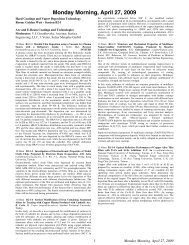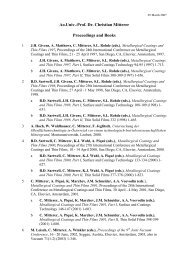ICMCTF 2012! - CD-Lab Application Oriented Coating Development
ICMCTF 2012! - CD-Lab Application Oriented Coating Development
ICMCTF 2012! - CD-Lab Application Oriented Coating Development
You also want an ePaper? Increase the reach of your titles
YUMPU automatically turns print PDFs into web optimized ePapers that Google loves.
Advanced Characterization of <strong>Coating</strong>s and Thin Films<br />
Room: Sunrise - Session TS2-1<br />
Advanced Characterization of <strong>Coating</strong>s and Thin Films<br />
Moderator: P. Schaaf, TU Ilmenau, Germany, F. Giuliani,<br />
Imperial College London - South Kensington Campus, UK,<br />
S. Korte, University of Erlangen-Nürnberg, Germany<br />
10:00am TS2-1-1 3D Microstructure Analysis of Thin Films and<br />
<strong>Coating</strong>s in the Micro, Nano and Atomic Scale, F. Mücklich<br />
(muecke@matsci.uni-sb.de), Saarland University and Materials Engineering<br />
Center, Germany INVITED<br />
The quantitative investigation of the correlation between processing,<br />
(spatial) microstructure and properties of coatings and thin films is one of<br />
the essential goals of their characterization strategies. The traditional 2D<br />
planar section sampling combined with estimations for the spatial situation<br />
is powerful but it supplies insufficient information for essential 3D<br />
characteristics such as particle volume density and arrangement or<br />
connectivity in cases of complex shaped microstructures. Advanced thin<br />
films therefore call for an adequate imaging and quantification of the 3D<br />
microstructure. Electron tomography is well established but may suffer<br />
from a lack of field of view size. Such representative field of view size can<br />
be achieved by the help of microstructure tomography based on FIB serial<br />
sectioning. This method combines the excellent target preparation<br />
possibilities of a focused ion beam (FIB) with all types of SEM contrast<br />
including EDX and EBSD. Therefore it enables the exploration of a<br />
representative sample volume and the imaging of chemical and structural<br />
phenomena with a resolution of a few nanometers. This can be combined<br />
locally with a tomography even at the atomic scale using Atom Probe<br />
Tomography.<br />
Once the 3D data set is available, their exploitation in 3D image analysis<br />
provide detailed quantitative insights into the relation between processing,<br />
structure and properties.<br />
So far, the complex formation of multiphase 3D microstructures, the related<br />
interface as well as seeding phenomena and also local degradation effects<br />
were investigated. The talk will provide an overview of microstructure<br />
tomography supported by examples of some technical relevance of<br />
coatings, thin films, and surface effects.<br />
10:40am TS2-1-3 Atom probe tomography of self-organized<br />
nanostructuring in Zr-Al-N thin films, L. Johnson (larsj@ifm.liu.se), N.<br />
Ghafoor, Linköping University, Sweden, M. Thuvander, K. Stiller,<br />
Chalmers University of Technology, Sweden, M. Odén, L. Hultman,<br />
Linköping University, Sweden<br />
The ZrAlN system has recently come under investigation [1] as a system<br />
that has an even larger miscibility gap than TiAlN, as well as a large lattice<br />
mismatch between ZrN and AlN. Atom probe tomography was performed<br />
on magnetron sputtered epitaxial Zr0.64Al0.36N thin films grown on<br />
MgO(001) substrates kept at 800 °C. A self-organized nanostructure was<br />
resolved, consisting of lamellae of Zr(Al)N and Al(Zr)N with a<br />
characteristic length scale of ~4 nm in the film plane and extending in the<br />
growth direction. In addition, Al was found to segregate to the<br />
film/substrate interface, forming a 1 nm thick layer. This was followed by<br />
growth of a 4 nm thick Al-depleted zone, self-organization of the Zr(Al)N<br />
and Al(Zr)N lamellas during 5 nm film growth, and finally steady-state<br />
growth of the lamellar structure.<br />
[1] L. Rogström, L.J.S. Johnson, M.P. Johansson, M. Ahlgren, L. Hultman,<br />
and M. Odén<br />
Scripta Materialia 62 (2010) 739-741<br />
11:00am TS2-1-4 3D FIB/SEM imaging and 3D EBSD analysis of<br />
compressed MgO micropillars, M. Ritter (ritter@tu-harburg.de),<br />
Hamburg University of Technology, Germany, S. Korte, W.J. Clegg, P.A.<br />
Midgley, University of Cambridge, UK<br />
The application of FIB/SEM (focused ion beam/scanning electron<br />
microscope) instruments is rapidly expanding. This is in part due to the fact<br />
that there is a pressing need to understand the structure, composition and<br />
physico-chemical properties of modern materials in three dimensions. FIB<br />
instruments can unveil sub-surface structural information by creating crosssections<br />
that can easily be imaged or analysed [1]; and serial crosssectioning<br />
expands the instrument’s capabilities to the third dimension.<br />
In the process of serial sectioning, small and thin slices of material are<br />
removed in bulk samples by means of FIB milling, creating a series of<br />
cross-sections in one direction of the sample. State of the art FIB/SEM<br />
instruments provide a focused ion beam with small spot sizes so that slices<br />
that are only a few nanometres thick can be removed from the bulk material.<br />
Monday Morning, April 23, <strong>2012</strong> 8<br />
Each cross-section can then be imaged and the crystal orientations retrieved<br />
by Electron Backscatter Diffraction (EBSD) [2]. The information can then<br />
be reconstructed and combined to provide a comprehensive dataset for 3D<br />
orientation analysis.<br />
One of the manifold applications is the possibility of characterising plastic<br />
deformation in brittle materials due the suppression of cracking in very<br />
small bodies. We used 3D EBSD as a way of characterising the threedimensional<br />
(3-D) deformation at high spatial resolution of MgO<br />
micropillars compressed ex situ along two crystal directions [3]. We show<br />
that for a successful 3D reconstruction of the indexed crystal orientations it<br />
is necessary to use the SEM images as reference to correct for offsets. It is<br />
also shown that for the reconstruction of compressed and then successively<br />
sliced and indexed MgO micropillars, this 3D technique yields information<br />
complementary to µ-Laue diffraction or electron microscopy, allowing a<br />
correlation of experimental artefacts and the distribution of plasticity.<br />
References<br />
[1] L. A. Gianuzzi et al., Introduction to Focused Ion Beams. Springer, New<br />
York, 2005.<br />
[2] S. Zaefferer et al., Mater. Sci. Forum 495-497 (2005) 3.<br />
[3] S. Korte et al., Acta Mater. 59 (2011) 7241.<br />
11:20am TS2-1-5 Recent Advances in XPS for the Characterization of<br />
Thin Films, D. Surman (dsurman@kratos.com), Kratos Analytical Inc.,<br />
UK, C. Blomfield, A. Roberts, S. Hutton, S. Page, Kratos Analytical Ltd.,<br />
UK<br />
X-ray photoelectron spectroscopy is the most widely applied of a range of<br />
surface analysis techniques. Small area analysis from an area of a few<br />
microns and imaging XPS with spatial resolution of a few microns is now<br />
common place. 1 The advent of small analysis area XPS heralded an era for<br />
XPS depth profiling where a sputter crater is formed by an ion beam<br />
(typically Ar) and then XPS analysis formed in the crater. In such a way<br />
thin films of up to 1-2 microns in thickness can be analysed. XPS depth<br />
profiles can therefore elucidate the chemical composition of a thin film with<br />
a depth resolution of a few nanometers . XPS can analyse films and<br />
substrate materials which are either insulating or conductive. An important<br />
factor in the characterization of thin films is the understanding of the<br />
chemistry of the various layers as well as the interfacial chemistry. In order<br />
to get a better understanding of this, non-destructive methods (chemically<br />
rather than necessarily materially) have been refined such as Angle<br />
Resolved XPS and the application of advanced mathematical modelling<br />
such as MEMS algorithms have enhanced the information that can be<br />
extracted. This technique has become especially powerful for very thin<br />
films.<br />
Other recent developments have focussed on improved ion gun design, by<br />
lowering the Ar ion energy improved interface resolution is possible. To<br />
date, XPS depth profiling has been principally applied to inorganic<br />
materials but the recent development of polyatomic ion guns using large<br />
carbon based molecules such as Fullerene or Coronene has expanded XPS<br />
depth profiling into organic materials 2 .<br />
Examples will be given here which describe the state of the art in XPS<br />
depth profiling utilizing both ARXPS and MEMS as well as chemically<br />
non-destructive profiling with Polyatomic ion species on both organic and<br />
inorganic materials. Examples of nanometer depth resolution and<br />
quantitative chemical composition of films of several hundred nanometers<br />
in thickness from a range of applications will be given.<br />
1. C.J. Blomfield, Journal of Electron Spectroscopy and Related Phenomena<br />
143 (2005) 41-249<br />
2. G.X. Biddulph, A. M. Piwowar, J.S. Fletcher, N.P. Lockyer, J. C.<br />
Vickerman, Anal, Chem, 79, (2007), 7259-7266.




